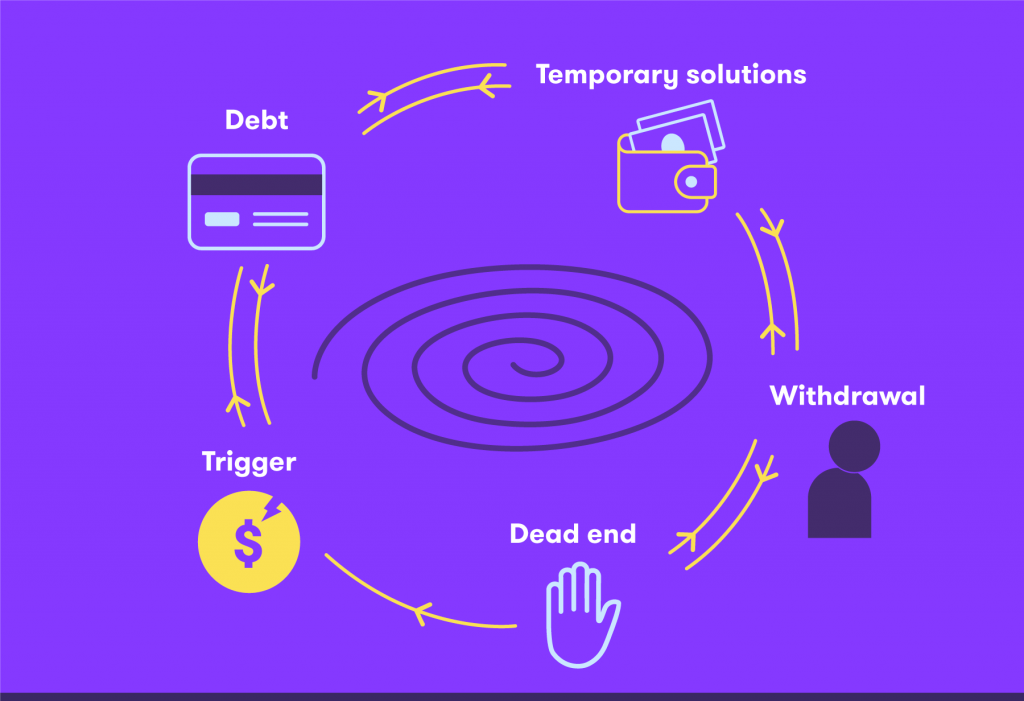
Being in debt isn’t a temporary situation... Unless you take action
Summary
Being in debt isn’t a temporary situation… Unless you take action
- No one ends up in serious debt overnight. It’s what happens when you live a little beyond your means for several years, until it finally catches up with you and makes your life difficult.
- Debts don’t take care of themselves. If you don’t get on top of them, they’re only going to build up.
- To get out of a debt spiral, you need to know the difference between good and bad debt, understand your budget and ask for help.
Different types of debt
Almost everyone has debt. You have a mortgage? That’s debt. Car loan? Also debt. But debts aren’t all bad. In fact, there are “good” debts and “bad” debts. There’s also a situation called “overindebtedness” that can happen whether you have “good” or “bad” debt.
What is “good debt”?
If you own a house, you probably have a mortgage. After all, you can’t expect to pay for a house in cash. This is an example of what we call “good” debt.
Why is it “good” debt? A few different reasons. First of all, when you take out a mortgage, your quality of life is immediately improved by having a family home. You don’t have to save up the full cost of a house, which takes about 25 years.
Secondly, having a mortgage helps improve your standing with financial institutions. Lastly, because mortgage loans have low interest rates (around 3.5%) and terms that are shorter than the lifespan of the asset you’re financing (often 20 to 30 years). In other words, you’ll still be using your home long after the mortgage is paid off.
What about “bad debt”?
“Bad” debts are purchases and loans that are subject to very high interest rates and that you have trouble paying on time. For example, financing a vacation with your credit card at a rate of 19% is bad debt. You might still be paying it off months (or years) after you get back! Leasing or buying a car that’s beyond your means and ending up with payments you can’t make is another form of bad debt.
What is overindebtedness?
So you can have “good” debt and “bad” debt. But bad or good, there’s always a risk of having too much. In other words, being “overindebted.”
Overindebtedness happens when a person is no longer able to make their payments on time. Late fees pile up. And the amounts you owe only grow as they accumulate interest.
When this happens, most people will say, “No big deal! I’m just going through a rough patch.” But money doesn’t just appear out of nowhere! And debts are never going to disappear on their own.
Once a person becomes overindebted, they fall into a pattern that looks like a spiral: a debt spiral.
How do people end up in a debt spiral? There are many different reasons. It could be a personal emergency or poor spending habits. No matter the cause, however, the stages in a debt spiral are largely the same.
The debt spiral explained

Take the quiz: Have you fallen into a debt spiral without realizing?
- Do you often borrow money to make ends meet?
- Are you unable to pay your rent on the first of the month?
- Do you use credit cards out of necessity rather than convenience?
- Do you get harassed by creditors?
- Do your cheques ever bounce?
- Do you cut back on groceries or other essential purchases to pay your debts?
- Do you only ever make the minimum monthly payment on your credit card?
- Do you ever use a credit card to pay down another credit card?
If you answered yes to one or more of these questions, you’re in a debt spiral. But all is not lost: Book an appointment with one of our advisors. They can help. It’s free and 100% confidential.
How to get rid of your debt
Step 1: Recognize that your financial troubles are not temporary. The sooner you admit this, the less time you’ll spend struggling in a debt spiral. And the less money you’ll waste paying nothing but interest, often at exorbitant rates.
Step 2: Make a monthly budget. What’s coming into and out of your pockets every month?
Step 3: With the help of an advisor, you’ll be able to find the best solution to fix your finances. You won’t have to feel like you’re always down to your last penny.
Step 4: Put your plan into action.
Step 5: Relax!


